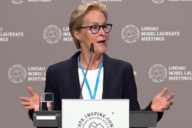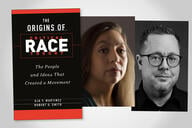You have /5 articles left.
Sign up for a free account or log in.
The conservative critique of college campuses can read like a zombie apocalypse story: Young Republicans must watch their backs at all times, or fall prey to the brain-eating (liberal) life form that pervades higher education. But new research suggests that while conservative students face marginalization, their experiences differ greatly from campus to campus. And although the overall experience can be difficult, it’s one they don’t regret.
Becoming Right: How Campuses Shape Young Conservatives, by Amy J. Binder, associate professor of sociology at the University of California at San Diego, and Kate Wood, a doctoral candidate in the department, is based on extensive interviews with self-identified conservative students and other research conducted at two institutions (which the authors don't identify, but describe as liberal) from 2008-9. The book, out this month from Princeton University Press, refers to the two institutions as “Eastern elite” and “Western flagship.” The former is a prestigious, relatively small university on the East Coast and the latter is a large, public university in a Western state (the institutions go unnamed due to a research agreement with Eastern elite).
While Binder and Wood find conservative students at both campuses share similar ideas and reasons for their beliefs, the authors said they were surprised to see how greatly political “styles” and experiences differ between campuses. Although a typical “campaigning” political style exists at both universities, Eastern elite students widely prefer a “civilized discourse” (or reasonable debate) to Western flagship students’ “provocative” approach (think affirmative action bake sales and global warming beach parties). This is due in large part to campus size; lower student-to-instructor ratios and closer interactions with peers at Eastern elite foster a sense of mutual respect and the desire to preserve social capital – even when politics differ. By contrast, bigger class sizes and less-frequent interactions with the same peers at Western flagship lead conservatives to feel more marginalized but also to be more activist.
“I expected there to be much greater resemblance because the conservative critique is widely disseminated,” said Binder. “And I selected these [two] schools because they’re kind of in the crosshairs of the conservative critique….. But I was really surprised at how university context makes a difference in how students experience being conservative.”
Binder said she was initially interested in researching conservatism – an understudied topic in sociology – in 2006, when national politics took a decidedly partisan turn. It’s partly coincidence that her interviews were conducted both during and immediately after the 2008 election, when youth were particularly engaged in the historic race. But the research transcends any one political moment, she said.
Wood, who became involved in the project in early 2009, said the book isn’t an attempt to debunk the conservative critique of higher education, but that it challenges some of its tenets. “For one thing, we found students changing in many different ways, and how they identified themselves politically on both campuses,” she said. “There were students who said before coming to college they identified as liberal, but became conservative at school. This is something that makes no sense in the world of liberal indoctrination.”
Conservative students at both universities face challenges, however.
Some female conservatives at Eastern elite feel judged by peers, who are “shocked” at their desire to have families instead of, or in addition to, prestigious careers. And both male and female students at Eastern elite seem acutely aware of how their collegiate political identities may be perceived by future employers. Western flagship conservatives, on the other hand, feel freer to express themselves. But at Western flagship, students talk at much more length about feeling marginalized on campus and having more contentious encounters with peers and even professors from across the aisle.
Still, students overwhelmingly say they wouldn’t want to change universities, which have helped shape their political identities. “With many of them, there was this sense that being in an environment they perceived to be overwhelmingly liberal did challenge them, but in ways that were positive and beneficial for them,” Wood said. “It made them clarify values and ideas about different issues or about what being a conservative means.”
Students at Eastern elite in particular say that being in the political minority enhanced their education, as some report doing extensive research before engaging in political debates with their friends. “You can’t be nasty, and they have to respect you because you’ve done the extra work,” one student says.
Terrence George, president of the Republican Club of Brown University, where he is a senior, said he hadn’t heard of Becoming Right, but noted similarities between Brown conservatives and those at Eastern elite. “Brown is certainly smaller than a big public university and conservative students here are given to more intellectual forms of expression than affirmative action bake sales,” he said, adding that his organization often hosts “right-leaning intellectuals and policy makers, not talking heads.”
Binder said she’d initially wanted to study up to six universities, but that doing two was more manageable, given the small size of her research team. Consequently, neither institution in the study is meant to be fully representative of others in its category. But important ideas about the impact of organizational structure, student-to-faculty ratio and other variables on students’ political style emerge nonetheless, she said.
Taylor Lane, a junior and College Republicans executive at the University of Colorado at Boulder (to which Western flagship bears a strong resemblance, as a state flagship with a popular annual drug celebration), said she hadn’t heard of Binder’s and Wood’s research, but that campus conservatives are “definitely atypical.” As such, they can be “shy” to “come out” and rarely share their views in class.
“In fact, we’re planning a day when all students will wear red ‘Rs’ to show that they’re Republican and encourage other students to do the same,” Lane said. “Of course we have exceptional conservative students who shamelessly represent their views on campus in every way possible, but for the most part I would say conservatives are shy on campus.”
Becoming Right already has attracted attention from the authors’ peers. Neil Gross, a University of British Columbia sociology professor and leading voice on politics in higher education, said in an e-mail that the book is a valuable contribution to the field “both because it takes a careful look at the experiences of conservative students and because it draws attention to political style, an understudied aspect of political life.”
Wood said she hoped professors and instructors would read the book, as it already had made her more aware of the political dynamics in her own interactions with students. “I think there is this assumption that college students are broadly liberal, and that’s something that can become problematic, because talking to conservative students and looking at national-level data about how students identify politically, they’re not all liberal, they’re actually moderate.”
Administrators also are a target audience, Binder said, and can learn from each campus how to avoid the “hived off” political centers that can create antipathy between student groups. “What we find is the more face-to-face sense of community there is, the less confrontation there will be. Large state schools can create that sense of community, but they’re not thinking about that right now.”





